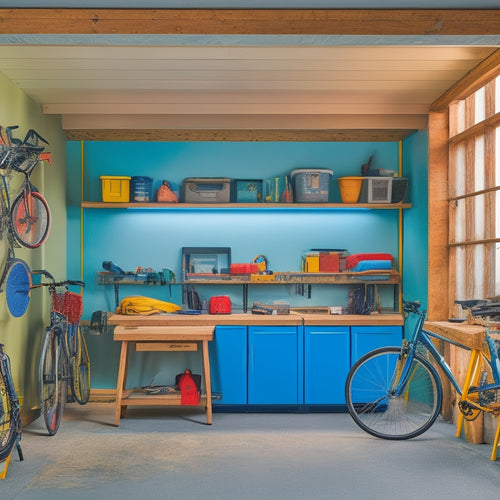
5 Essential Tips for Organizing Keys With Pegboards
Share
You're wasting around 10 minutes a day searching for misplaced keys, but a well-organized pegboard system can help you reclaim that time. Start by choosing the right pegboard size for your space and key quantity. Then, categorize and group similar keys by category, color-code, and priority. Label each key for easy identification, and use the right hooks and accessories to maximize space. Finally, keep frequently used keys accessible in a designated "hot spot" and store spare keys separately for emergencies. By following these 5 essential tips, you'll be well on your way to a stress-free key organization system that saves you time and hassle.
Key Takeaways
• Consider available space and key quantity when choosing a pegboard size to ensure a maximum fit.
• Group and categorize keys by type, color-coding, and frequency of use to prevent key jumbling.
• Label keys with unique codes, color-coding, and brief descriptions for easy identification and retrieval.
• Utilize hooks and accessories of varying sizes to accommodate different key types and separate them with dividers or bins.
• Designate a 'hot spot' for frequently used keys and store spare keys in a separate system for emergencies.
Choose the Right Pegboard Size
When selecting a pegboard, you need to take into account the available space and the number of keys you want to organize to choose the right size. Measure the space where you plan to install the pegboard to determine the maximum size that will fit comfortably.
Consider the layout of the area, too - if it's a narrow hallway, a longer, thinner pegboard might be more suitable, while a wider pegboard might work better in a larger room.
Next, think about the number of keys you need to store. If you have a small collection, a compact pegboard with a few hooks might suffice. But if you have a large number of keys, you'll need a larger pegboard with more hooks or a pegboard with adjustable hooks to accommodate different key sizes.
Categorize and Group Similar Keys
Now that you've chosen the right pegboard size, it's time to think about how to arrange your keys in a way that makes sense, and that starts with categorizing and grouping similar keys together. This is an essential step in key organization, as it allows you to quickly find the key you need.
Start by grouping keys by category, such as house keys, car keys, and office keys. Within each category, you can further group keys by color coding. For example, you can use red hooks for house keys, blue hooks for car keys, and green hooks for office keys.
When grouping similar keys together, consider the frequency of use and the significance of each key. Place the most frequently used keys in easy-to-reach locations, and reserve the less accessible areas for less frequently used keys.
Designate specific hooks for each key, ensuring that each key has its own designated spot. This will prevent keys from getting jumbled and make it easier to find the key you need.
Label Keys for Easy Identification
You can take your key organization to the next level by labeling each key with its corresponding purpose, making it easy to identify which key belongs to which lock. This simple step can save you time and frustration when searching for the right key. By labeling your keys, you'll never again have to try multiple keys to open a door or cabinet.
Here are some ways to label your keys effectively:
-
Use a key tracking system: Assign a unique number or code to each key and keep a record of what each key opens.
-
Color coding keys: Use different colored labels or tags to categorize keys by type, such as house keys, car keys, or office keys.
-
Add a brief description: Write a short description of what each key opens, such as 'front door' or 'office cabinet.'
- Use a label maker: Invest in a label maker to create clear, easy-to-read labels for your keys.
Utilize Hooks and Accessories Wisely
By thoughtfully selecting and arranging hooks and accessories on your pegboard, you can create a customized key organization system that streamlines your daily routine. This is where you can get creative and maximize space while adding some decorative options.
Here are some ideas to ponder:
| Hook Type | Key Type | Benefits |
|---|---|---|
| Small hooks | Small keys (e.g., mailbox, padlock) | Saves space, keeps small keys organized |
| Medium hooks | Standard keys (e.g., house, car) | Accommodates most key sizes, easy to access |
| Large hooks | Large keys (e.g., bike, garage) | Holds bulky keys, keeps them from getting tangled |
When choosing hooks and accessories, think about the types of keys you need to store and how you want to access them. Ponder using dividers or bins to separate keys by category or frequency of use. You can also add a small tray or dish to catch loose items like keychains or key fobs. By utilizing hooks and accessories wisely, you'll be able to create a pegboard that's both functional and visually appealing.
Keep Frequently Used Keys Accessible
Position your most regularly used keys in easily accessible locations on the pegboard, making sure they're readily available when you need them. This will save you time and frustration when you're in a rush. By keeping your most-used keys front and center, you'll avoid having to search through a cluttered key storage system or dig through a crowded key rack.
Here are some tips to keep in mind:
-
Designate a 'hot spot': Assign a specific area on your pegboard for your most frequently used keys, making them easy to grab on the go.
-
Use key holders with labels: Use key holders with labels or color-coding to quickly identify which key is which, saving you time and effort.
-
Group similar keys together: Organize your keys by category, such as house keys, car keys, or office keys, to make them easier to find and access.
- Keep spare keys handy: Store spare keys in a separate key organization system, such as a key box or key safe, to make sure you always have a backup when you need it.
Frequently Asked Questions
Can I Use a Pegboard for Keys in a Small Apartment or Dorm Room?
You can definitely use a pegboard for keys in a small apartment or dorm room, as long as you optimize your wall space and choose decorative options that fit your style and available area.
How Do I Prevent Keys From Getting Scratched on the Pegboard?
Imagine your prized keys getting scratched on a pegboard - ouch! You prevent this by using key protection strips or scratch-preventing pegboard alternatives, ensuring your keys remain damage-free and organized for easy access.
Are Pegboards Suitable for Outdoor or Garage Key Storage?
You're wondering if pegboards are suitable for outdoor or garage key storage. Yes, they can be! Look for pegboards with outdoor durability, weather-resistant materials, and a rust-proof coating to guarantee they withstand garage storage conditions.
Can I Customize a Pegboard to Fit My Specific Key Collection?
You can definitely customize a pegboard to fit your specific key collection, allowing you to maximize key organization and create a personalized pegboard key display that suits your unique needs and style.
How Often Should I Clean and Maintain My Pegboard Key Organizer?
You'll want to clean your pegboard key organizer every 1-2 months, depending on usage, using a soft cloth and mild soap to wipe down hooks and pegs, and occasionally dusting with a gentle brush.
Related Posts
-

7 Essential Foldable Workbenches for Garages
When selecting a foldable workbench for your garage, you'll want to contemplate factors such as space-saving design, ...
-

What Size Rolling Storage Bin Do I Need
To determine the ideal size of your rolling storage bin, you'll need to measure your storage space accurately, consid...
-

Building Garage Shelves in 7 Easy Steps
You're about to convert your garage into a highly functional storage space by building custom shelves in just 7 easy ...


